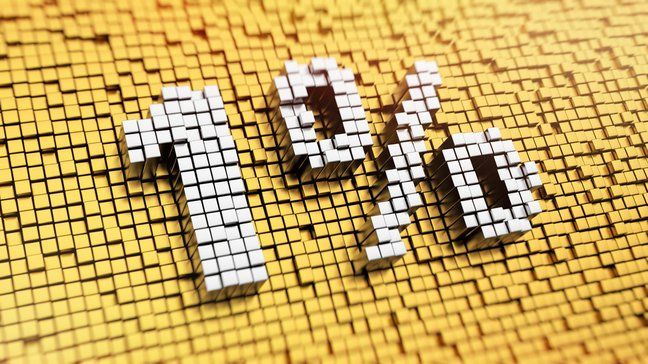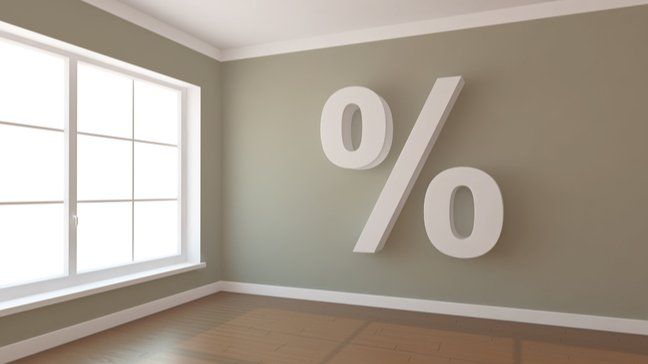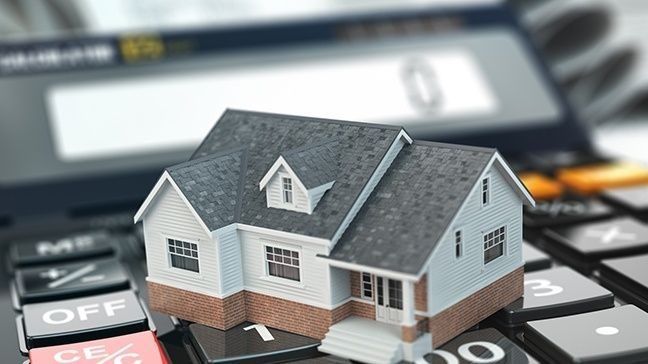When you start looking to buy a house, you’ll hear all about mortgage rates and how much it sucks that they’re going up, how great it is if they’re going down, or even why low mortgage rates aren’t always a good thing.
Your mortgage rate is simply the amount of interest charged by the lender you use to purchase your house.
So how do you get to this percentage? And how will it really affect how much you pay? For the purposes of this article, I’ll take a look at how just a 1% difference in your mortgage rate can seriously affect how much you pay.
As you’ll see in the table below, a 1% difference between a $200,000 home with a $160,000 mortgage increases your monthly payment by almost $100. Although the difference in monthly payment may not seem that extreme, the 1% higher rate means you’ll pay approximately $30,000 more in interest over the 30-year term. Ouch!
What’s Ahead:
- A Quick Primer on How Interest Rates Work on Mortgages
- How a 1% Difference in Your Mortgage Rate Affects How Much You Pay
- What’s Currently Happening with Mortgage Rates?
- How to Get the Lowest Rate Possible
- Other Determining Factors in Your Mortgage Rate
- Mortgage Points — Here’s Why they Matter
- Summary
A Quick Primer on How Interest Rates Work on Mortgages
A mortgage is a type of loan used to purchase a home or other real estate. The interest rate on a mortgage is the percentage of the total loan amount that you will have to pay in addition to the principal, or original, loan amount.
The interest rate on a mortgage is usually expressed as an annual percentage rate, or APR. This means that you will have to pay back the loan plus interest charges over the course of the life of the loan. The interest rate on a mortgage can be fixed or variable, depending on your lender’s terms and conditions.
If you have a fixed-rate mortgage, then your interest rate will not change over the life of the loan. But if you have an adjustable-rate mortgage, then it can fluctuate based on the Prime rate, for example.
How a 1% Difference in Your Mortgage Rate Affects How Much You Pay

In this example, let’s say you’re looking to take out a home loan for $200,000. If you get a 30-year mortgage and you make a 20% down payment of $40,000, you’ll have a $160,000 mortgage.
If you only put down 10%, you’ll have a $180,000 mortgage. The following table shows you how much you’ll pay — both per month and over the life of the loan — in each scenario.
| Mortgage rate | Payment, 20% down | 30-yr. interest, 20% down | Payment, 10% down | 30-yr. interest, 10% down |
|---|---|---|---|---|
| 3.5% | $718 | $98,780 | $808* | $111,058 |
| 4% | $764 | $115,280 | $859* | $129,481 |
| 4.5% | $811 | $132,129 | $912* | $148,345 |
| 5% | $858 | $149,641 | $966* | $167,992 |
| 5.5% | $908 | $167,302 | $1,022* | $187,938 |
| 6% | $959 | $185,522 | $1,079* | $208,632 |
| 6.5% | $1,011 | $204,302 | $1,137* | $230,119 |
| 7% | $1,064 | $223,630 | $1,197* | $251,584 |
| 7.5% | $1,118 | $243,481 | $1,258* | $273,670 |
*Payment amounts shown do not include private mortgage insurance (PMI), which may be required on loans with down payments of less than 20%. The actual monthly payment may be higher.
This calculation also does not include property taxes, which could raise the cost substantially if you live in a high-tax area.
In this example, a 1% mortgage rate difference results in a monthly payment that’s close to $100 higher. But the real difference is how much more you’ll pay in interest over 30 years…more than $33,000! And just think, if you lived in the 1980s when the highest mortgage rate was 18%, you’d be paying thousands a month just in interest!
You can calculate your own mortgage rate using our simple mortgage rate calculator.
Read more: Mortgage Rates Briefly Explained
What’s Currently Happening with Mortgage Rates?
COVID-19 pushed mortgage interest rates down to record lows, dipping to a jaw-dropping 2.67% in December 2020. But they’ve since climbed back up to pre-pandemic levels, reaching a 7% average as of October 2022.
But don’t feel too bummed out. Consider that back in the 80s, a typical mortgage rate was between 10% and 18%, and a 7% rate doesn’t seem too bad, comparatively. Of course, the cost of real estate has risen since then, but mortgage rates themselves are still substantially lower than they could be.
How to Get the Lowest Rate Possible
Unfortunately, you don’t have a great deal of personal control over the average interest rates offered at any given time. But you do have quite a bit of control over the rates you’ll be offered relative to the average.
The first step to ensuring you’ll get the lowest rate possible is to shop around for multiple offers.
Credible is an online marketplace where you can get competitive mortgage rates from multiple, vetted lenders in real-time. It makes the entire mortgage process easy, from getting preapproved to closing, and requesting rates won’t affect your credit. You’ll start by filling out a quick application that will give you quotes from multiple lenders. If you like one of the quotes, you can link up to your bank accounts and upload documents to make the process not only quick, but paperless.
Another option for getting quotes is Fiona. With Fiona, you compare and shop for mortgage rates from multiple lenders at once, so you can easily decide which offer is the best for your needs. Your credit score won’t be checked until you decide to move forward with one of the lenders, so there is no need to worry about hurting your score just for pre-qualifying. The service is 100% free, and you’re under no obligation to go with any of the lenders who provide a quote.
Credible Operations, Inc. NMLS# 1681276, “Credible.” Not available in all states. www.nmlsconsumeraccess.org.” Credible Credit Disclosure - To check the rates and terms you qualify for, Credible or our partner lender(s) conduct a soft credit pull that will not affect your credit score. However, when you apply for credit, your full credit report from one or more consumer reporting agencies will be requested, which is considered a hard credit pull and will affect your credit.Other Determining Factors in Your Mortgage Rate

Aside from thoroughly researching several different lenders, there are a handful of key variables that will influence the rates you’re offered:
Credit
Your credit score will be one of the biggest factors in determining your mortgage rate.
Your mortgage is a loan, so like any other loan, you’ll need a very good credit score to qualify for the best rate. This means a FICO score of at least 700. To get the best rates, a score above 740 is even more desirable.
Down Payment
The bigger your down payment, the lower the mortgage rate. If you put down 20% or more, lenders see you as a lower risk because you have as much at stake in the property as they do.
Not only your down payment, but your loan length determines your rate, for the same reason. The shorter your loan, the less risk for the lender. So, if possible, a 15-year mortgage is better than a 30-year mortgage.
Read more: How to Best Save for a Down Payment on a House
Income Stability
Your lender obviously wants to know that you have a stable job so you can pay off the loan they’re giving you.
If you’ve just changed careers, own your own business, earn your income mostly from freelancing, or have less than a consistent two-year work history, you’re less likely to get the best rates.
These scenarios demonstrate that your financial situation has been subject to change in the past. Even if you own your own seemingly stable business, this still makes you a greater risk because you have more to lose.
Read more: Getting a Mortgage When You’re Self Employed
Area
Where you live can have a bearing on your rate. Rates vary by state and tend to be based on how well the housing market is doing in your state.
If the market is healthy where you’re looking, a lender will likely charge a lower rate because there’s less of a risk of default.
Type of Loan
There are different types of loans you may qualify for that impact your mortgage rate.
15-year and 30-year mortgages are the most common, with 20% typically required as a down payment. However, FHA loans (which get their name from the Federal Housing Administration) require much smaller down payments (as little as 3.5%). On the other hand, FHA loans may also require the homeowner to purchase private mortgage insurance, which protects the lender against default.
Mortgage Points — Here’s Why they Matter
In the mortgage world, there are these things called points. In the simplest terms, a point is an upfront fee paid to lower your interest rate by a fixed amount (usually 0.125%).
For example, if you take out a $200,000 loan at 4.25% interest, you might be able to pay a $2,000 fee to reduce the rate to 4.125%.
Paying points makes sense if you: 1) have the cash to pay them AND you 2) plan to hold the loan for a long time.
If you don’t hold the loan long enough, the upfront cost of paying points often outweighs interest savings over time. You’ll want to consider points carefully. If you’re fairly certain that you will stay in your home for a long time and that you will not pay off the mortgage or refinance early, points can save you a good deal of money.
If, however, you pay points and, just a few years later, move, refinance, or pay off your mortgage, you’ll likely fare worse than if you did not pay points and instead took out a loan with a higher rate.
Summary
In short, mortgage rates matter. While a difference of 1% may not seem substantial, even when you’re comparing monthly mortgage payments on a modest loan amount, the additional amount you could end up paying in interest is staggering.
And, of course, the larger your loan amount, the greater these differences will be. Being able to qualify for a low mortgage rate will keep your monthly payment lower, yes, but it’ll also allow you to save tens of thousands of dollars over your lifetime.


